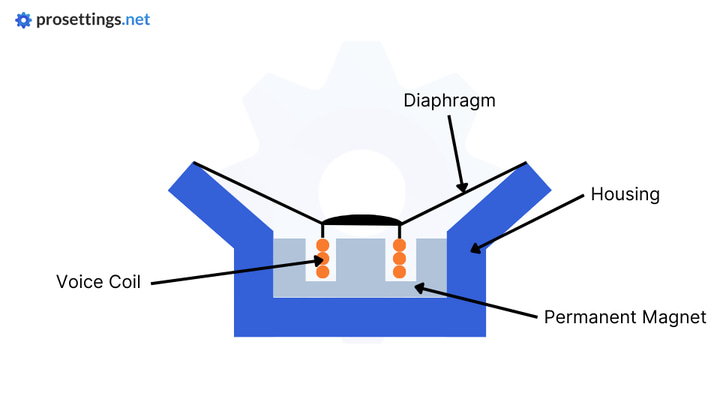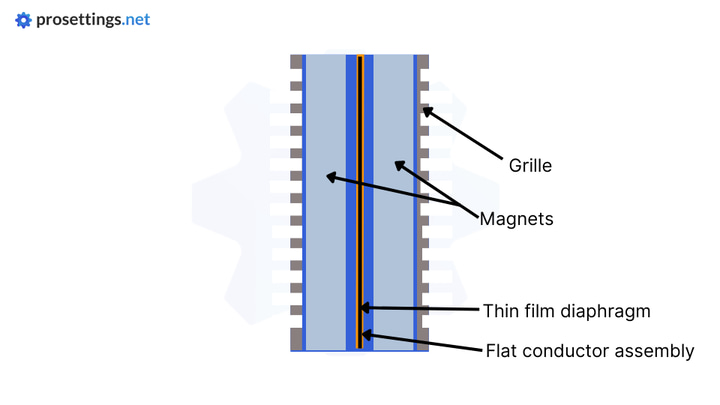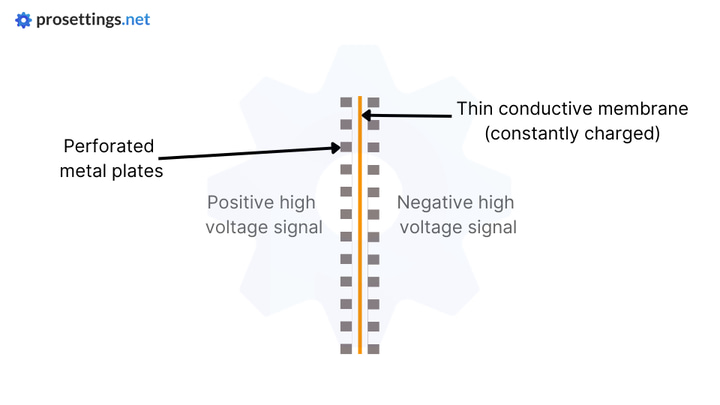Headphone Drivers Explained

The world of (gaming) headphones is an incredibly complex and deep one, and it can be very difficult to find your bearings in this audio rabbit hole. In order to untangle the proverbial wires and help users make the best purchasing decisions we’re shining our light on the beating hearts of headphones: drivers. We outline various driver types as well as their pros and cons so that you can make an informed decision on your next audio purchase.
If you’re looking for a new gaming headset, you can also check out our best gaming headset article.
What are Headphone Drivers and How Do They Work?
A headphone driver is basically the component that creates sound. A driver converts electrical signals into sound waves that can be heard by the user. Different drivers use different technologies and materials to create these sound waves, giving them different characteristics.
In case you’re not familiar: ‘sound’ is basically a form of energy that’s caused by vibrations in the air. When an object vibrates, it causes the air molecules around it to move, and these movements travel through the air in waves (hence ‘soundwaves’) until they reach our ears (or die out). These waves are received by our ears, and our brains then perceive them as the sounds that we know: music, speech, engine noise,… The higher the frequency (i.e. the number of times that a wave repeats itself) of a wave, the higher pitched the sound is and vice versa. The unit of frequency is Hertz (Hz) and humans can generally hear sounds between 20Hz and 20000Hz. That’s a very basic and surface-level explanation, but it’s necessary to understand how drivers work.
In a nutshell, then, a headphone driver creates the waves of sound that reach your ear. They usually are made up out of three parts:
Magnet
Generates a magnetic field. The stronger the magnet, the better the sound (generally speaking) since stronger, larger magnets are able to move more air. These permanent (i.e. with an always present magnetic field) magnets interact with the voice coils in order to create vibrations
Voice Coil
A coil of (generally) copper wire that’s in contact with the diaphragm that becomes electromagnetic when electricity runs through it, causing it to interact with the magnets inside the driver. The push/pull interaction between the magnets and the coils makes the coils vibrate and move the diaphragm.
Diaphragm
A very thin piece of material (usually mylar) that moves when the voice coil starts moving and thus acts as a very tiny drum. The vibrations of the diaphragm send sound waves through the air, which are then perceived as music/speech/… by our ears and brains. You can clearly see the diaphragm on speakers without a front grille: they are the usually cone-shaped parts that very clearly vibrate at higher volumes.

Is There a Best Headphone Driver?
There are certainly drivers that focus more on sound quality than others. Something like a bone conduction driver quite simply isn’t made with pure sound quality in mind, so if you’re only talking about sound then there are definitely drivers that will perform better than others, but even then the sound of a headphone (or speaker) greatly depends on the implementation of the drivers, the choices of material, and so on.
At this point, it’s also important to mention the fact that ‘sound quality’ is personal. Of course everyone will be able to tell the difference between a $5 pair of earbuds that someone got in a goodie bag and a $500 pair of headphones that’s made by an audio company that’s focused on delivering the clearest sound quality, but when comparing two $500 headphones to each other you’ll usually find that opinions on which one is the best are beginning to spread out a little more.
That’s all because we all have different preferences. Person A might prefer a very thumping bass sound and use that as a ‘mark of quality’ while person B might want a more neutral sound, for example. Things like distortion and clarity can be (somewhat) objectively measured, but there is no single ‘perfect’ pair of headphone (driver) that will work for everyone.
Something that is objectively true is that you want your diaphragm to be as rigid and light as possible. If the material is too bendy, it will bend and twist when rapidly vibrating (causing the sound waves to be warped, which distorts the sounds) and if the diaphragm is too heavy it will not respond quickly enough, which will also lower the overall sound clarity. This presents a challenge for manufacturers, as ‘lightness’ isn’t always associated with rigidity, so manufacturers are always looking for ways to create drivers that create clear, undisturbed sound waves.
Does the Amount of Headphone Drivers Matter?
More drivers can definitely result in a better sound (something that’s commonly seen is having one driver handling the bass frequencies, while others produce the higher frequencies) but quality over quantity is something that applies here. If you’re using a bunch of badly tuned drivers, your headset will sound poor and there’s no amount of (badly tuned) drivers that will change that. Using a multi-driver setup also generally requires more engineering, testing, and tuning, making it more complex (and thus costlier) to implement.
As we mentioned before, a lot of what makes a pair of headphones a good pair of headphones comes from optimization and engineering work. Audio equipment is incredibly delicate, and it’s not as simple as just cramming a bunch of the most expensive drivers into an enclosure and calling it a day.
In short: yes, more drivers can result in a more accurate and cleaner sound, but that’s not the case by default. Well-tuned, quality single driver headphones/earphones can definitely beat multi-driver setups.
Different Types of Headphone Drivers
Different drivers have different use cases as well as their own pros and cons, so we’ll go over the various headphone drivers and explain how they work.
Dynamic Driver / Moving Coil Driver
Dynamic drivers are the most common and often used headphone drivers due to the fact that they’re cheap and require low amounts of power, meaning that you don’t need a separate amplifier to use dynamic drivers.
In a dynamic driver, the voice coil is directly connected to the diaphragm and sits inside a permanent magnet. When an electrical signal (from an audio source in this case) moves through the coil, it becomes electromagnetic, causing a constant state of attraction and repulsion between the permanent magnets and the voice coil, causing the coil to rapidly vibrate. This vibration in turn causes the diaphragm to move (since it is connected to the voice coil) which causes the air molecules around it to be disturbed, and that produces sound waves.
Dynamic drivers are widely used in all types of audio equipment and are a cost-effective way of making audio equipment. Due to their size (relative to some other drivers) they are capable of producing punchy bass sounds, but they are prone to distort at higher volumes due to the way they are built.
Diaphragm materials
In dynamic drivers, the diaphragm is of great importance. A diaphragm should be as lightweight as possible, while still being rigid enough so as to not bend and disform (which creates distortions) when it’s being pushed hard. Most cheap drivers use a material such as mylar, and while the quality of these mylar diaphragms can also vary greatly, engineers are always looking for the next material that can serve as an ideal diaphragm in dynamic drivers.
Graphene, which is a rather new material, is one such material, and it has long been a kind of ‘holy grail’ diaphragm material. Logitech recently came out with the world’s first (gaming) headset featuring graphene drivers (as opposed to graphene-coated drivers) with the G Pro X 2 LIGHTSPEED headset, showing that headphone technology is always moving forward.
Pros
- Affordable
- Good bass response
- Decent frequency range
Cons
- Can quite easily distort

Balanced Armature Driver
Balanced armature (BA) drivers are very common in earbuds and in-ear monitors due to the fact that they’re so compact and don’t require a lot of power to drive.
A BA driver takes an electronic signal from an audio source and uses it to move a tiny armature (wrapped with a coil of wire) that sits between two magnets inside a small enclosure. When the electronical signal reaches the armature, it becomes electromagnetic, which leads it to vibrate between the two magnets. The drive pin at the end of the armature causes the diaphragm to move, which in turn causes air molecules around it to move and create sound waves that come out of the small ‘nozzle’ at the end of the BA driver housing.
The closed-off nature of BA drivers means that they’re great at sound isolation, and they’re also capable of producing high quality sounds (though BA drivers typically lack in the bass department because of their tiny size) but they do have very specific frequency ranges. This means that you typically need more than one driver if you want to create an audio product that offers great sound quality, and that combined with the fact that they’re more expensive than a typical dynamic driver can make for expensive products.

Pros
- Very compact
- Lightweight
- Good at isolation
Cons
- Bass response can be lacking
- Narrow frequency range
Planar Magnetic Driver
The definition of planar is ‘of, relating to, or lying in a plane‘, and that partially gives away how a planar magnetic driver works.
A planar magnetic driver works similarly to a dynamic driver, though a planar magnetic driver doesn’t use coils but rather a flat electrical conductor assembly that sits between two flat magnets on a very thin and fragile film that acts as the diaphragm. When an electronic signal gets sent to the flat conductor array, it becomes electromagnetic, making the diaphragm (the thin film) vibrate due to the attraction and repulsion between the conductor array and the two magnets on either side of the diaphragm.
Because of the flat, thin diaphragm and less moving parts (when compared to a traditional dynamic driver) these drivers produce a very accurate and clean sound and are generally less prone to distort. The diaphragm is very thin and responsive, making it react quickly to changes in the electronic audio signal. All of this makes them a great choice for higher end headphones that focus on sound quality and fidelity.
Because of the fact that planar magnetic drivers use larger magnets (that are naturally also heavier) they are more expensive than dynamic drivers. Headphones that use planar magnetic drivers are also often on the bulkier side and generally require an external amplifier to get the best out of them.

Pros
- Very responsive
- Great sound quality
- Doesn’t distort easily
Cons
- Expensive
- Heavy and bulky
- Rather power-hungry
Electrostatic driver
Electrostatic drivers are among the most expensive drivers on the market. They need special amplification in order to drive them, so these uncommon and highly specialized drivers are not something that you will see in consumer-grade headphones.
Electrostatic drivers use static electricity as opposed to (electro)magnetism to drive sound to the user.
Electrostatic drivers use razor-thin membrane that’s covered in conductive coating for a diaphragm. This film is thin and small enough so that static electricity can move it. The membrane holds a constant electrical charge and sits between two electrified perforated metal plates. One plate holds a positive charge while the other holds a negative charge so that the diaphragm stays exactly in the middle, and when an audio signal is received, the metal plates alternate their charges, causing the diaphragm to vibrate and produce sound waves.
Due to the fact that electrostatic drivers have almost no physically touching components, they can produce a very accurate sound with almost no distortion. The small size and incredibly low weight of the diaphragm also makes the headphones very responsive.

Pros
- Top tier audio quality
- Extremely responsive
Cons
- Requires special amplifiers to drive
- Very expensive
Piezeoelectric driver
Piezoelectricity is the electric charge that accumulates in certain solid materials (crystals, ceramics, …) and piezoelectric drivers use this principle to drive sound.
The shape of piezoelectric materials changes slightly when electricity runs through them. Piezoelectric drivers use a thin diaphragm made out of a piezoelectric material, which then changes shape and vibrates when electricity gets introduced. Piezoelectric drivers are extremely sensitive, but they are difficult to work with and can lack in bass response due to their size so they are not often used in audiophile-grade products.
Piezoelectric drivers are rather rare in headphones and are commonly used in combination with other drivers these days, though interest in them is growing again due to the introduction of bone conduction drivers for runners and other fans of outdoor sports.
Pros
- Very sensitive
Cons
- Bass response is lacking
- Lower overall audio quality
Bone conduction driver
Bone conduction drivers are unique in the sense that they transmit sound by applying vibrations to our skull and jawbones. They use a piezoelectric crystal that sits between two metal plates which, when an audio signal is applied to them, make the crystal shrink and expand. When this crystal is applied to a solid material such as human bones, the vibrations of the crystal will extend into the bones, which causes the bones in the skull to vibrate ever so slightly, causing the inner ear to send the vibrations to the brain.
Bone conduction drivers are relatively new and due to the fact that they don’t block your ear canal they are ideal for runners or other sportspeople who still need to be aware of their surroundings. Consequently, they are not ideal for gaming due to the lack of isolation and lower quality positional audio.
Pros
- Doesn’t block ear canal so it’s ideal for people who need to stay aware of their surroundings
Cons
- Sound quality isn’t good
How to Choose the Right Headphone Driver
As we mentioned earlier on in the article, there is no ‘best’ headphone driver type. The sound of a headphone (or really any audio product) is influenced by a ton of things, including the choices of materials, the implementation and tuning of the drivers, and so on.
You also need to consider the practical aspects. If you need a headphone that’s going to be used for commuting then you won’t want to get a pair that requires an external amplification, for example.
For gaming, we recommend the same drivers that any audiophile would recommend. This means that bone conduction drivers (for example) are, generally speaking, not a great idea for gaming. The most important factors for gaming headphones are clear and precise audio quality and an accurate soundstage so that you can tell exactly where that reloading enemy is positioned, and those are qualities that are also coveted by audiophiles.
Conclusion
The world of audio can be compared to the mechanical keyboard world. On the surface, it seems very simple, but once you really dive into all the possible options and configurations out there you realize that it’s a very deep rabbit hole indeed. Contrary to mechanical keyboards, where the upper limit for a board is around $1500 (unless you’re diving into custom-machined cases and what not) there is pretty much no limit to how far you can go with audio products.
Luckily, you don’t need to spend thousands in order to get a great pair of headphones. There are tons of options out there that sound great and won’t cost you multiple monthly wages, but as we said before: it’s also a matter of finding out what sound profile and sound characteristic you like. This guide should help you navigate the world of headphones with a little more confidence, and hopefully it can help you get started on your own personal audio journey.


